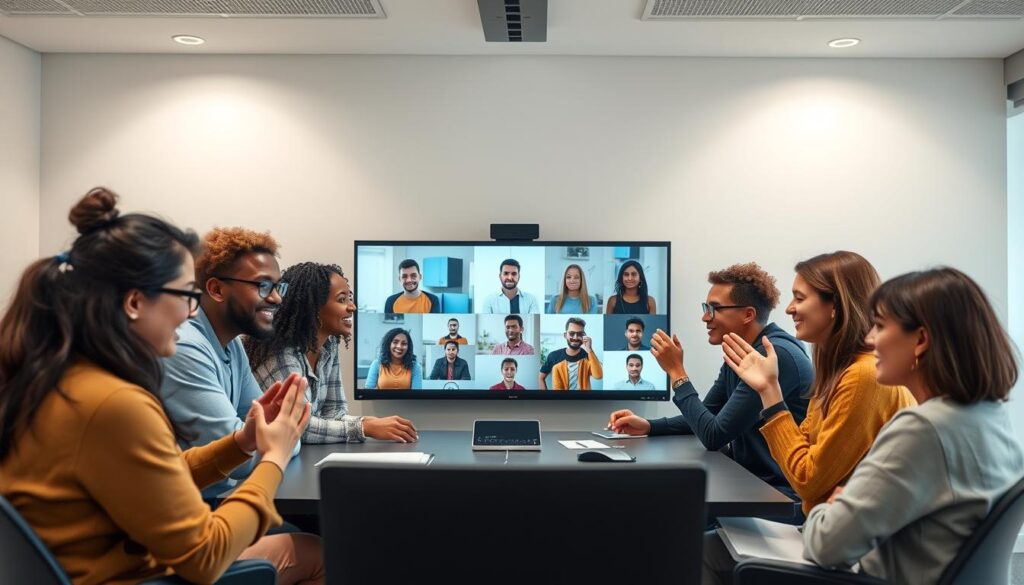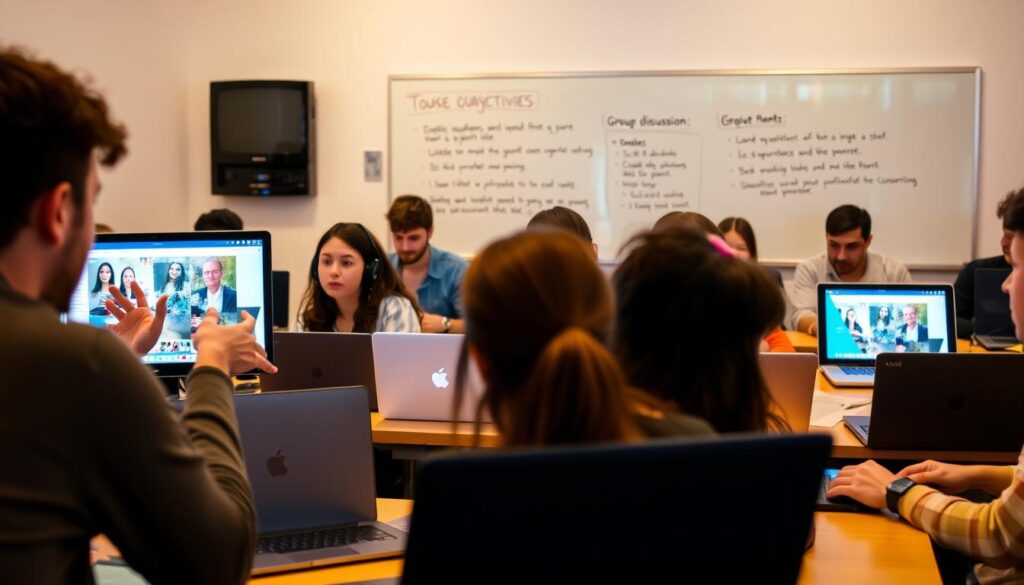The Importance of Peer Groups in Virtual Learning
Online education has become increasingly popular, and peer groups play a vital role in enhancing the virtual learning experience.
By fostering a sense of community and promoting social interaction, peer groups help mitigate the isolation often associated with online learning.
Studies have shown that peer groups improve engagement, collaboration, and learning outcomes in virtual learning environments.
As online education continues to evolve, understanding the significance of peer groups is crucial for educators, policymakers, and learners alike.
What Are Peer Groups in the Virtual Learning Landscape?
Peer groups in virtual learning settings provide students with opportunities to engage in online discussions, share knowledge, and develop teamwork skills. In the virtual learning landscape, peer groups are formed when students come together to achieve common learning objectives, leveraging technology to facilitate collaboration and knowledge sharing.

Through online discussions, group projects, and peer-to-peer feedback, students can develop a deeper understanding of the subject matter while cultivating essential skills such as communication, teamwork, and problem-solving. By working together in peer groups, students can gain diverse perspectives and insights, enriching their learning experience in the virtual classroom.
Online collaboration is a key aspect of peer groups in virtual learning, enabling students to connect with one another and engage in meaningful learning experiences. Educators can facilitate the creation of peer groups, ensuring that students are able to work effectively together and achieve their learning objectives.
The Importance of Peer Groups in Virtual Learning
In the virtual learning landscape, peer groups are essential for fostering a sense of community and connection among students. The absence of face-to-face interaction can often lead to feelings of isolation, which can negatively impact a student’s academic performance and overall well-being.
Building Community in Virtual Environments
Peer groups help combat isolation by providing students with opportunities to interact, share experiences, and support one another through online discussions, group activities, and social events. By facilitating these interactions, educators can help students develop a sense of belonging and connection.

Building a sense of community in virtual environments is crucial for creating an engaging, inclusive, and effective learning environment. When students feel connected to their peers, they are more likely to participate in class, share their ideas, and collaborate on projects. This, in turn, can lead to improved academic outcomes and a more satisfying learning experience.
The importance of peer groups lies in their ability to provide emotional support, foster a sense of camaraderie, and promote a collaborative learning environment. By leveraging peer groups, educators can create a more dynamic and supportive virtual learning environment.
How Peer-to-Peer Learning Transforms the Virtual Classroom
By leveraging peer-to-peer learning, educators can create a more interactive and student-centered virtual classroom. This approach involves students interacting with each other to exchange knowledge and solve problems collaboratively.
Communication Tools and Techniques play a vital role in facilitating peer-to-peer learning. Tools such as video conferencing software, discussion forums, and instant messaging apps enable students to engage in real-time discussions, share resources, and work together on projects. Effective communication techniques, including clear instructions and active listening, are also crucial for successful collaboration.
The use of various communication tools allows students to stay connected and work together seamlessly. For instance, video conferencing tools facilitate face-to-face interactions, while discussion forums provide a platform for asynchronous discussions. Instant messaging apps enable quick queries and feedback.
Project Management in Virtual Teams
Project management is also essential in virtual teams, enabling students to coordinate their efforts, set goals, and track progress. By using project management tools, students can organize tasks, share documents, and monitor their progress, ensuring that projects are completed efficiently.
In conclusion, peer-to-peer learning transforms the virtual classroom by fostering a collaborative and interactive learning environment. By leveraging appropriate communication tools and techniques, and effective project management, educators can enhance student engagement and learning outcomes.
Overcoming Challenges in Virtual Peer Group Implementation
Effective virtual peer group implementation requires overcoming several hurdles through strategic planning. One of the primary challenges is fostering a sense of community and connection among group members who may never meet in person.
Icebreakers and Team-Building Activities
To address this, educators can utilize icebreakers and team-building activities designed to help students get to know one another and establish trust. These activities can be as simple as introductory discussions or collaborative projects that require group members to work together towards a common goal.
For instance, using virtual breakout rooms for small group discussions can facilitate personal connections. Additionally, incorporating team-building activities that encourage problem-solving and collaboration can help build a cohesive group dynamic.
Establishing Group Norms and Expectations
Another crucial aspect is establishing clear group norms and expectations. By setting clear guidelines and roles within the group, educators can ensure that students understand their responsibilities and what is expected of them. This clarity can help prevent misunderstandings and conflicts, promoting a smoother and more productive group experience.

By implementing these strategies, educators can overcome the challenges associated with virtual peer group implementation, creating a more effective and engaging learning environment for their students.
Designing Effective Virtual Peer Group Experiences
To foster a sense of community and cooperation, educators must carefully design virtual peer group experiences. This involves considering several key factors that contribute to successful online collaboration and engagement in virtual learning environments.
Group Size and Composition are critical in determining the effectiveness of virtual peer groups. A group that is too large can be overwhelming, while a group that is too small may lack diverse perspectives. Educators should aim for a balance, ensuring that groups are large enough to foster diverse discussions but small enough to encourage active participation from all members.
The duration of virtual peer group activities also plays a significant role. Activities that are too short may not allow for meaningful interactions, while those that are too long can lead to participant fatigue. Educators should carefully plan the duration of these activities to keep students engaged without overwhelming them.

Technology and facilitation strategies are equally important. The use of appropriate digital tools can enhance collaboration and engagement. Moreover, effective facilitation by educators can guide discussions, ensure that activities stay on track, and foster a positive learning environment.
By carefully considering these factors and implementing effective assessment methods, educators can create virtual peer group experiences that are not only engaging but also conducive to achieving desired learning outcomes.
Engaging Peer Group Activities That Drive Learning Outcomes
To drive learning outcomes, educators must incorporate engaging peer group activities into their virtual classrooms. These activities not only promote deeper learning but also increase student motivation and overall satisfaction with the course.
One of the key factors in designing effective peer group activities is the choice of collaboration tools. Educators can choose between synchronous and asynchronous tools, each with its own advantages. Synchronous tools, such as video conferencing software, allow for real-time interaction and immediate feedback.
Synchronous vs. Asynchronous Collaboration Tools
Synchronous collaboration tools facilitate face-to-face interaction, which can enhance the sense of community and teamwork among students. On the other hand, asynchronous tools, such as discussion forums and collaborative document editing, provide flexibility and allow students to contribute at their own pace.
To maximize participation across different time zones, educators can combine both synchronous and asynchronous tools. For instance, they can use video conferencing for live sessions and discussion forums for ongoing discussions.
Maximizing Participation Across Time Zones
By being mindful of the challenges posed by different time zones, educators can design activities that cater to the needs of all students. This might involve recording live sessions for students who cannot attend in real-time or using collaborative tools that allow students to contribute at their convenience.
In conclusion, engaging peer group activities are crucial for driving learning outcomes in virtual learning environments. By choosing the right collaboration tools and being mindful of the challenges posed by different time zones, educators can create inclusive and effective learning experiences.
Research-Backed Benefits: What the Data Shows About Virtual Peer Learning
Research indicates that virtual peer learning not only enhances learning outcomes but also fosters a sense of community among students. This is achieved through collaborative activities that encourage knowledge sharing and mutual support.
Improved Learning Outcomes: Studies have shown that virtual peer learning leads to significant improvements in academic performance. By engaging in peer-to-peer discussions and collaborative projects, students gain a deeper understanding of the subject matter.
Increased Student Engagement: Virtual peer learning also promotes higher levels of student engagement. When students are actively involved in the learning process, they are more likely to stay motivated and invested in their education.
The data supporting virtual peer learning is compelling. Educators can leverage this evidence to design more effective virtual learning environments that promote academic success and student satisfaction.
By understanding the research-backed benefits of virtual peer learning, educators can make informed decisions about how to integrate this approach into their teaching practices, ultimately enhancing the quality of virtual education.
Conclusion
As online education continues to evolve, the importance of peer groups in virtual learning environments is becoming increasingly evident. By fostering a collaborative and engaging learning environment, peer groups play a vital role in enhancing the overall online education experience.
The potential of virtual peer learning to transform online education is significant, with research-backed benefits that include improved learning outcomes and increased student satisfaction. Educators who understand the importance of peer groups can create more effective learning environments, ultimately leading to better academic results.
By leveraging the power of peer groups, educators can revolutionize the virtual classroom, making it more interactive and engaging. As the education landscape continues to shift, the role of peer groups in virtual learning will only continue to grow, making it essential for educators to prioritize their implementation.







